|
Air Power |
In 1965 Nikita Khrushchev, who did not think highly of air forces and who stopped many developing aviation programmes, left active political life. Also, in 1965, the United States formulated specification for a new Advanced Manned Strategic Aircraft (AMSA), which would be the B-1. This together with the already ongoing development of the XB-70 Valkyrie bombers, inspired the Soviet government to specify requirement for a strategic bomber. On 28 November 1967 the competition for the new strategic bomber began. Technical parameters were high. The aircraft was to reach 11000 to 13000 km (5,970 to 7,020 nm) and have a cruising speed of 3200 to 3500 km/h. The maximum range at subsonic speed was to be 16000 to 18000 km (8,640 to 9,720 nm) at high altitude. Basic armament was to be nuclear missiles, including heavy Kh-45 and small Kh-2000s.
Sukhoi came with a variable-geometry winged version of the T-4, named T-4M. Due to the arrangement of the engines, the weapons would have to be carried externally. Sukhoi abondoned the design and started a new program, named T-4MS, although it had nothing in common with the original T-4. The T-4MS would be capable of meeting the demands and carry two Kh-45 missiles inside a bomb bay, as well as two Kh-45 externally.
Myasishchev's Design Bureau disbanded when it stopped work on the M-50 'Bounder' design in 1960. In October 1966 it was reinstated under the name of EMZ - Experimentalnyi Maschinostroitelnyi Zavod (Experimental Engineering Plant). Myasishchev worked on four different designs under designation M-20 in 1967-1968.
Tupolev, which was formally called Moscow Engineering Plant 'Opyt' (meaning Test), joined Sukhoi and Myasishchev in the quest for a supersonic strategic bomber. Tupolev's design team had the best chance, because of the bureau's experience with bomber aircraft dating back to the 1930s. Unlike the others, Tupolev started designing by not aiming at the specifications given by the government. Tupolev thought a Mach 3.0 to 3.2 bomber, compared with a Mach 2.3, did not off-set the cost of construction and technology. In the early 1970s Tupolev prepared a series of flying-wing designs designated 160M, which were based on the contemporary delta-winged Tu-144 supersonic airliner.
In 1972 the air forces selected Sukhoi as the winner, however it was realised a design with these specifications was not possible. So it was decided to start a second stage of the competition. The maximum speed was lowered to Mach 2.3 enabling Tupolev's 160M flying-wing design to enter the competition. Myasishchev came with the M-18, based on the M-20 design which had a variable-geometry wing. Sukhoi gave up the competition and decided to concentrate on fighter aircraft.
The air force selected the M-18, because of its variable-geometry wing design and the design was supported by TsAGI (large and powerful Soviet technical research institute) and the Technological-Scientific Council of the Ministry of Air Industry. Tupolev's flying-wing design was a single-mode aircraft and the air force required bomber following a compound flight profile and be able to also land at 'smaller' airfield.
Myasishchev's winning design was developed by the Tupolev bureau, because the former's team was too small. In 1973 the first design for the Tu-160 was prepared by Tupolev based on the M-18 variable-geometry design. The design was gradually improved and Tupolev began selecting the aircraft systems, together with the scientific and government research institutes. The NK-25 engine of the Tu-22M3 were selected at first, but the high fuel consume rate required a new development. In 1980 the first Nk-32 was testflown on a Tu-142 and production began in 1983.
Aleksei Tupolev (son of Andrei Tupolev, founder of the design bureau) lead the Tu-160 design program during the initial period, in 1975 Valentin Bliznyuk was appointed as chief designer and remains in charge of the program today. In 1977 the preliminary design and a full scale mock up were submitted for state committee acceptance. At this stage the aircraft would carry two Kh-45 missiles. During the Strategic Arms Limitation Treaty II (SALT II) talks in the late 1970s, the plans for a new strategic bomber and the name Tu-160 were first revealed to the west.
When the Soviets learned about the American AGM-86 ALCM-B cruise missile, the requirement of the Kh-45 as main armament for the Tu-160 was dropped and a strategic (nuclear) version of the Kh-55 cruise missile was developed. The Tu-160 armament would now consist of 12 Kh-55SM missiles, with 12 to 24 Kh-15 being the alternative. Although there was enough time to design the weapon bays after the plans for Kh-45 were dropped, the Tu-160 design held its long weapon bays. The Kh-55SM and Kh-15 are much shorter, and can be launched with only the forward longer doors openened (each weapon bay has four doors). One reason may be the possibility of the Meteorit-A missiles to be carried by the Tu-160, but these missiles did not pass their test.
Initially a traditional self-defence system was proposed for the Tu-160, including a tail turret with a 30mm GSg-6-30 cannon. However the designer replaced the plans later during developed with the Baykal system. Also the plans for R-77 medium-range air-to-air missiles were abondoned.
The program was accepted in 1977 and Tupolev began production of three prototypes. Although the aircraft were assembled at Tupolev's workshop at Moscow, the sub-assemblies were built at other production plants. However the first prototype 70-01 intended for flight testing the basic flight characteristics had incomplete equipment. Prototype 70-02 was built for static tests. Prototype 70-03 was practically an equivalent of series production aircraft. 70-01 was completed at Zhukovskity in January 1981. On 14 November, the aircraft taxied the airstrip for the first time, after months of testing. On 25 November 1981 a picture was taken of the aircraft near two Tu-144 by a landing passenger at a nearby airfield, this was the first picture of the Tu-160 revealed to the world.
On Friday 18 December 1981 Tu-160 70-01 made its maiden flight. Three months later the first supersonic flight was achieved. And during one of the test flight the top speed of 2200 km/h was reached. The 70-01 can be distinguished from the other Tu-160 by having a long probe at the nose tip. Internally there are greater differences in equipment and structural elements. Work on new materials and engineering methods, lead to postponement of the 70-03 prototype, which did not take off until 6 October 1984.
Series production was started at Ulyanovsk production plant, but was soon replaced to KAPO (Kazan Aviation Production Association) in favor of the An-124 production. The first series Tu-160 took off from Kazan on 10 October 1984. The first aircraft to enter service took off from Kazan on 15 August 1986.
On 23 April 1987 this aircraft as well as a second example were delivered to the 184th Heavy Bomber Regiment of Guards, based at Pryluky airfield in the Ukaine. The squadron had previously been operating the Tu-16 Badger, so it obtained a small number of Tu-22M3 'Backfire-C' to train the crew on high supersonic bombers, with a variable-geometry wing. Later the Tu-134UBL dedicated trainer for the Tu-160 replaced the Tu-22Ms. At the end of 1991, the 184th regiment had two squadron and a total of 19 Tu-160 were delivered.
The first time the Tu-160 was shown to the public was on 20 August 1989 flying over Tushino airfield in Moscow. The first ground presentation was in August 1992 at MosAeroshow held at Zhukovskiy. It made its international debut at the Paris Airshow in June 1995, were it was presented as space carrier for the Burlak space vehicle with a mock up of the Burlak under its belly.
After the break up of the Soviet Union the Ukainian parliament took all military units based in its country under control. At first this had no effect on the 184th bomber regiments. But in 1992 25% of the pilots and personnel swore oath to the Ukraine. At Engels airbase in Russia, the first Russian Tu-160 regiment was formed. Russia had just three Tu-160 remaining at the Kazan factory. On 16 February the first arrived at Engels AB, but because of lack of pilots it was not until 29 July 1992 when the first Tu-160 took off from Engels. The production at Kazan continued for a short while until the air force ran out of money and in June 1994 the sixth and last Tu-160 left the factory for Engels. Four unfinished airframes remained at Kazan.
The Ukrainian 19 Tu-160 from the 184th regiment were flown only a small number of sorties, before they were grounded because of lack of technical support from Tupolev and manufacturer, lack of spares and lack of fuel. Also the Ukraine did not have areas suitable for training with strategic missiles. The Ukraine could not sustain the aircraft and had no need for them, so they started negotiations with Russia in 1991. When in 1998 no agreement was reached, Ukraine decided to scrap the aircraft. The first Tu-160 was cut up in November 1998.
In April 1999, Russia proposed buying back eight Tu-160 and three Tu-95MS 'Bears' which were in the best technical condition, as well as 575 Kh-55 and Kh-55SM missiles, documentation and ground equipment. On 6 October 1999 an agreement was signed and a total of US$285 million was deducted from the Ukraine's outstanding payments to Russia for the supply of natural gas. On 5 November the first two bombers, a Tu-160 and a Tu-95MS, landed at Engels AB. The last two Tu-160 'Blackjacks' arrived at Engels on 21 February 2000. All the aircraft were overhauled at the Kazan factory during 2001. On 5 May 2000, another aircraft that was nearly finished aircraft was commissioned into service at Engels as '07'.
The 182nd Heavy Bomber Regiment of Guards operated 15 Tu-160 'Blackjacks' after all eight Ukrainian Tu-160 were returned into service. In September 2003 one Tu-160 bomber was lost in a fatal crash. Reportedly production restarted work on another one of the unfinished Tu-160 airframes at Kazan to replace the lost bomber. This is the second Tu-160 bomber to be lost in a crash, in 1987 the first Tu-160 (a series production test aircraft) crashed due to an engine problem.
The total number of Tu-160 Blackjacks built was 35 at the end of 2000, comprising of 3 prototypes built in Moscow and 32 series aircraft built in Kazan. Three unfinished aircraft remain at the Kazan factory today. Of the 11 Tu-160 airframes that remained in the Ukraine 1 serves as a gate monument, while the remaining 10 were cut up. The last Ukrainian Tu-160 was cut up in 2001.
Specifications:
Function: long-range strategic penetration bomber and missile platform
Contractor: Tupolev
Crew: 4
Powerplant: four 25,000-kg (55,115 lb) afterburning thrust Kuznetsov NK-321 turbofans
Production today:
Prototype aircraft 3
Development/Test Russia 6
1987-1991 Delivered Pryluky, Ukraine 19
1991-2000 Delivered Engels, Russia 7
(Remaining at Kazan factory) (3)
Total Aircraft Built 35(+3)
Airworthy today:
Prototype 1
Development/Test Russia 3
1987-1991 Delivered Pryluky, Ukraine 8
1991-2000 Delivered Engels, Russia 6
Total Aircraft Airworthy 18
Dimensions:
Length: 177 ft 6 in (54.10 m)
Wingspan: 182 ft 9 in (55.70 m)
Height: 43 ft 0 in (13.10 m)
Weights: Empty: 260,140 lb (118,000 kg) / Maximum Takeoff: 606,261 lb (275,000 kg)
Performance :
Speed: 1,243 mph (1,079 kt)
Ceiling: 52,500 ft (16.000m)
Range: 8,699 miles (14,000 km)
Armaments:
provision for 16500 kg (36.376 Ib) of disposable stores carried in two lower-fuselage weapon bays and on hardpoints under the wing gloves; typical weapons are free-fall nuclear and/or HE bombs, and/or missiles including up to 12 RK-55 (AS-15 'Kent') cruise missiles or 24 RKV-500B (AS-16 'Kickback') short-range attack missiles.
More details and history at: TU-160 Blackjack and at Fas.Org
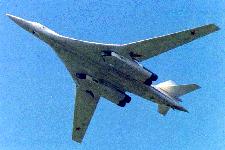
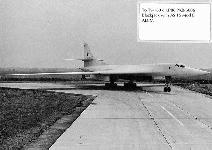
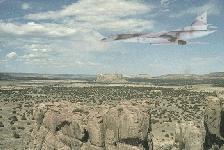
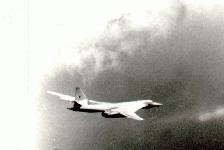


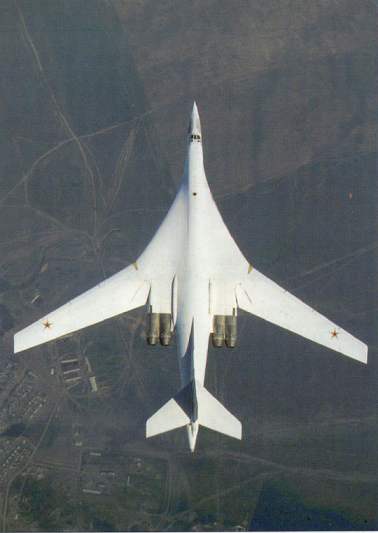

All information and photos Copyright of Fas.org, GlobalAircraft.org and DansHistory.com
